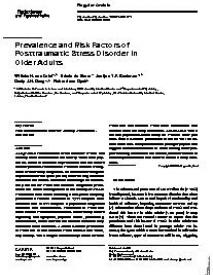Prevalence and Risk Factors of Posttraumatic Stress Disorder in Older Adults
Background: Posttraumatic stress disorder (PTSD) has scarcely been researched in the elderly. There is no population-based information on prevalence and risk factors in older persons. Patients with PTSD are often not recognized or incorrectly diagnosed. As the disorder has great implications for the quality of life, a correct diagnosis and treatment are crucial. Increased knowledge on vulnerability factors for PTSD can facilitate diagnostic procedures and health management in the elderly.
Methods: PTSD cases were found following a two-phase sampling procedure: a random selection of 1,721 subjects were screened and in 422 subjects a psychiatric diagnostic interview was administered. Prevalence of PTSD and subthreshold PTSD were calculated. Vulnerability factors regarding demographics, physical health, personality, social factors, recent distress and adverse events in early childhood were assessed.
Results: 6-month prevalence of PTSD and of subthreshold PTSD was 0.9 and 13.1%, respectively. The strongest vulnerability factors for both PTSD and subthreshold PTSD were neuroticism and adverse events in early childhood.
Conclusions: This is the first population-based study on PTSD in older persons. With a 6-month prevalence of almost 1% the disease is not rare. Comparisons with younger populations suggest some accumulation of cases among older people reflecting the chronic risk factors, which are found in this study: neuroticism and adverse events in early childhood.
Geachte bezoeker,
De informatie die u nu opvraagt, kan door psychotraumanet niet aan u worden getoond. Dit kan verschillende redenen hebben,
waarvan (bescherming van het) auteursrecht de meeste voorkomende is. Wanneer het mogelijk is om u door te verwijzen naar de bron
van deze informatie, dan ziet u hier onder een link naar die plek.
Als er geen link staat, kunt u contact opnemen met de bibliotheek,
die u verder op weg kan helpen.
Met vriendelijke groet,
Het psychotraumanet-team.
In: Psychotherapy and Psychosomatics ; ISSN: 0033-3190 | 72 | 6 | november december | 333–342
https://doi.org/10.1159/000073030


